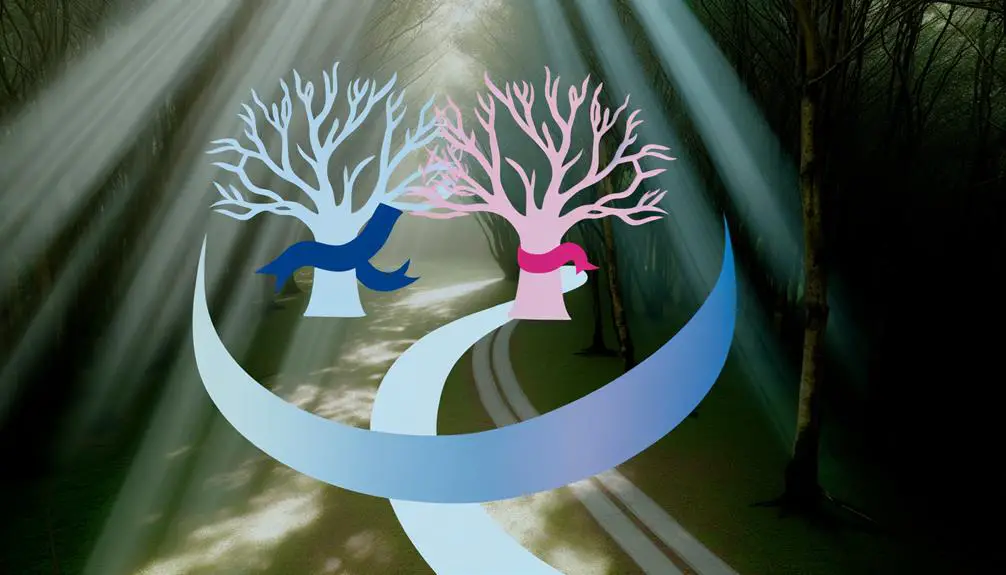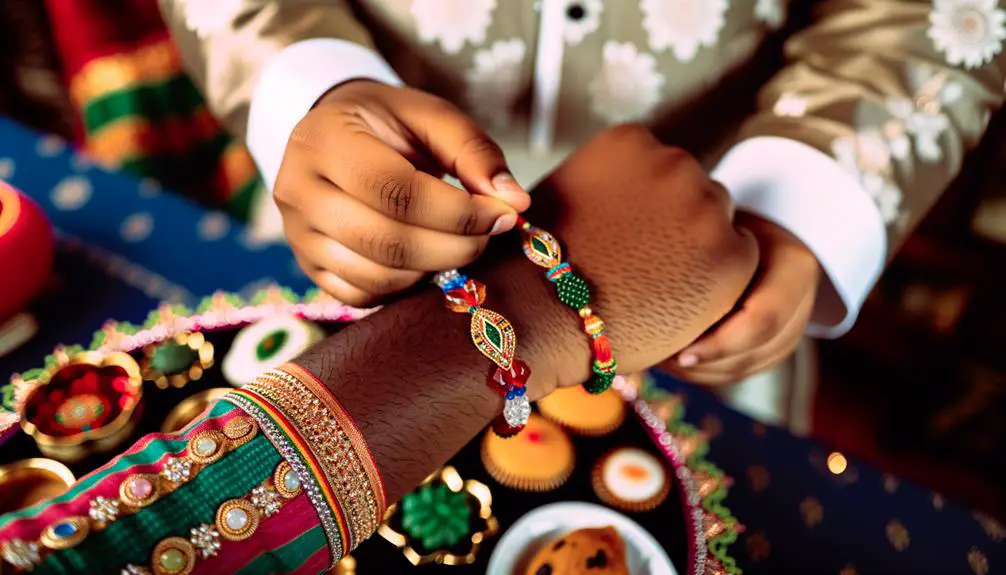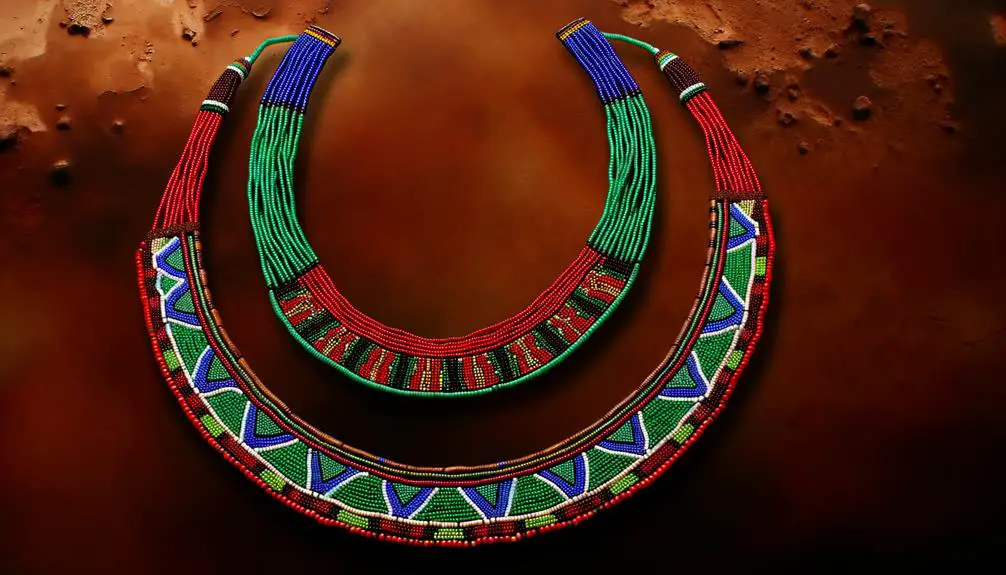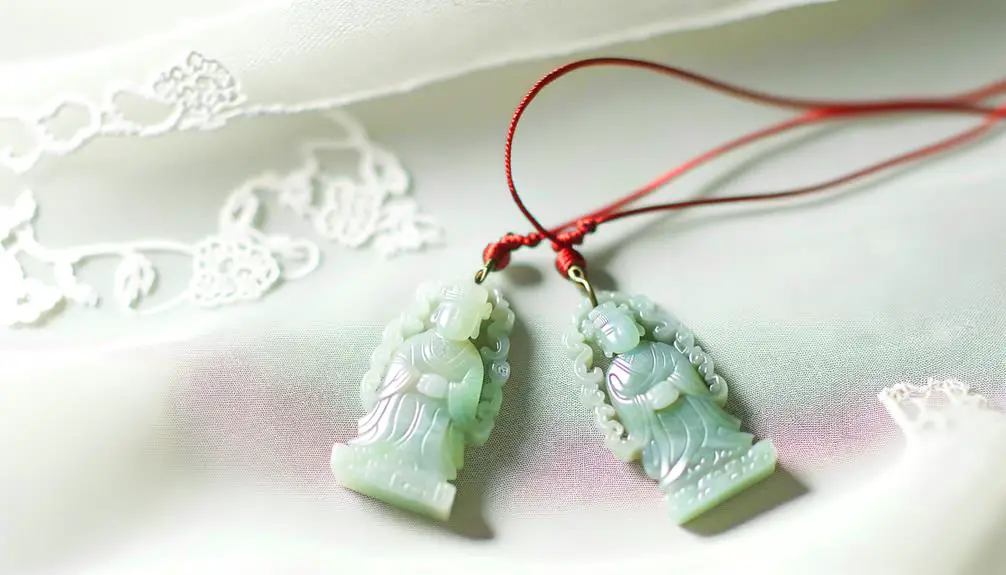10 Timeless Symbols of Brother and Sister Bond
Symbols of brother and sister bonds are deeply rooted in various cultures. The Rakhi, an Indian tradition, represents protection and love.
The Celtic Knot signifies an eternal, unbreakable connection. Native American totems express ancestral heritage and familial bonds, while Japanese Hina Dolls reinforce familial connections through their craftsmanship.
African beaded jewelry reflects cultural identity and familial ties, and Greek mythology's symbols of Apollo and Artemis stand for loyalty and mutual respect. Chinese jade pendants denote unity and protection, while Viking runes signify strength and unity.
Modern jewelry trends celebrate these themes with customized and sustainable designs. There's much more to explore in these rich traditions.

Key Takeaways
- Rakhi represents protection and love between siblings in Indian culture.
- Celtic Knot signifies an eternal and unbreakable connection between brothers and sisters.
- Apollo and Artemis in Greek mythology symbolize loyalty, protection, and mutual respect among siblings.
- Chinese jade pendants symbolize protection, prosperity, and unity, reinforcing sibling bonds.
- Viking runes represent protection, strength, and unity in familial relationships.
Rakhi: The Thread of Protection

Rakhi, a sacred thread tied by sisters on their brothers' wrists, symbolizes a pledge of protection, love, and mutual respect. This tradition, rooted in Indian culture, transcends mere ritual to embody a profound emotional bond.
The act of tying a rakhi is more than symbolic; it represents a promise of support and care. Brothers, in turn, vow to safeguard their sisters, reflecting a mutual commitment. This exchange of vows strengthens familial ties and reinforces societal values of unity and compassion.
Analyzing this custom reveals its role in nurturing relationships, serving as a reminder of the enduring bond between siblings. Rakhi, hence, is a powerful emblem of brotherhood and sisterhood, fostering a sense of belonging and shared responsibility.
Celtic Knot: Eternal Connection
In Celtic tradition, the intricate designs of the Celtic Knot symbolize an unbreakable and eternal connection between loved ones, reflecting the deep and enduring bond akin to that of siblings. The endless loops of these knots, which have no beginning or end, beautifully represent the infinite nature of love and loyalty. This symbolism resonates deeply with the concept of sibling relationships, which are characterized by unwavering support and mutual respect. The Celtic Knot serves not only as a decorative element but also as a poignant reminder of the enduring ties that bind brothers and sisters.
| Element | Symbolism |
|---|---|
| Endless Loops | Infinity, Eternity |
| Interwoven Paths | Interconnected Lives |
| No Beginning/End | Timelessness |
| Continuous Design | Unbreakable Bond |
Native American Totems

Native American totems offer profound insights into the intricate family bonds and the revered significance of animal symbolism within these cultures.
These totems serve not only as emblems of personal and familial identity but also as crucial instruments for preserving cultural heritage.
Understanding the multifaceted roles of totems fosters a deeper appreciation for the ancestral wisdom and traditions they embody.
Totems and Family Bonds
Totems play an important role in expressing and reinforcing the deep family bonds within many Native American cultures. These sacred symbols often represent ancestral lineage and heritage, serving as a tangible link between generations. Totems are not merely decorative; they encapsulate stories, values, and the collective identity of a family or clan. They offer a sense of continuity, grounding individuals in shared history and traditions.
Through rituals and communal gatherings, totems foster unity and mutual respect among family members. They serve as a constant reminder of the interconnectedness and responsibilities within the family unit. Understanding the significance of totems helps appreciate the profound ways in which Native American families maintain their bonds and cultural integrity.
Animal Symbolism Significance
Beyond their role in symbolizing family lineage, animals depicted in totems carry profound meanings that reflect the values, strengths, and spiritual beliefs of Native American cultures. These symbols serve as guiding principles and sources of inspiration.
For instance:
- The Eagle: Represents vision, freedom, and connection to the divine, embodying a powerful spiritual presence.
- The Bear: Symbolizes strength, courage, and protection, often seen as a guardian spirit.
- The Wolf: Stands for loyalty, community, and perseverance, highlighting the importance of social bonds and survival.
Cultural Heritage Preservation
Recognizing the profound cultural and spiritual significance of Native American totems, efforts to preserve these symbols are crucial in maintaining the rich heritage and identity of indigenous communities. Totems serve as essential links to ancestral traditions, embodying stories, values, and histories. Preservation initiatives must be inclusive, respecting the autonomy and knowledge of native tribes. Effective strategies include community-led projects, legal protections, and educational programs. The following table illustrates key aspects of cultural heritage preservation:
| Aspect | Description | Example |
|---|---|---|
| Community Involvement | Engaging tribal members in preservation | Totem restoration workshops |
| Legal Protections | Enforcing laws to safeguard totems | Sacred Sites Protection Act |
| Education | Raising awareness through learning | School programs on totem heritage |
| Funding | Securing financial resources | Grants for cultural projects |
| Documentation | Recording and archiving totem histories | Digital archives of totem stories |
Such measures guarantee the enduring legacy of these symbolic artifacts.
Japanese Hina Dolls
Japanese Hina Dolls hold profound historical significance as they symbolize prayers for the health and happiness of girls. The intricate craftsmanship of these dolls, often passed down through generations, reflects a deep cultural heritage and dedication to artistry.
Understanding these aspects provides valuable insights into the cultural fabric that binds siblings and families in Japan.
Historical Significance Explained
Hina Dolls hold a profound cultural and historical significance in Japan, symbolizing the celebration of familial bonds and the protection of children during the annual Hinamatsuri festival. This tradition, dating back to the Heian period (794-1185), has evolved to incorporate the following key elements:
- Symbolic Protection: Hina Dolls are believed to ward off evil spirits, safeguarding young girls from harm.
- Cultural Heritage: The dolls represent an important transfer of cultural values and historical narratives across generations.
- Expression of Affection: Displaying Hina Dolls is an act of love and care, reinforcing familial connections and the nurturing of children.
Understanding these aspects helps appreciate the deep-rooted customs and the warmth they bring to Japanese families, reflecting a society that values history and kinship.
Detailed Craftsmanship Insights
Meticulously crafted by skilled artisans, each doll in the Hina collection showcases intricate details that reflect a profound dedication to traditional Japanese artistry.
The dolls are often adorned with meticulously painted faces and elaborate silk kimonos, each stitch and brushstroke exemplifying precision and care.
The artisans' techniques are passed down through generations, ensuring that each piece maintains its cultural authenticity and artistic integrity.
Understanding these dolls requires an appreciation for the painstaking efforts involved, from sculpting delicate facial expressions to hand-sewing miniature garments.
This craftsmanship not only honors historical traditions but also creates a tangible connection to Japan's rich cultural heritage.
For enthusiasts, recognizing these details fosters a deeper respect for the artisans' labor and the dolls' cultural significance.
African Beaded Jewelry

African beaded jewelry, with its vibrant colors and intricate designs, serves as a profound symbol of cultural identity, social status, and familial bonds. These exquisite pieces are not merely ornamental; they encapsulate the rich histories and traditions of diverse African communities. The craftsmanship involved in creating these beads highlights a deep respect for ancestral knowledge and artistic expression.
Key aspects of African beaded jewelry include:
- Cultural Identity: Each bead color and pattern signifies specific tribal affiliations and cultural narratives.
- Social Status: Jewelry often indicates the wearer's social rank, age, and marital status within the community.
- Familial Bonds: Beaded jewelry is frequently exchanged during important family ceremonies, symbolizing unity and continuity.
This intricate artistry fosters a sense of belonging and heritage.
Greek Mythology Symbols
Greek mythology symbols, steeped in ancient lore, offer profound insights into the values, beliefs, and cultural psyche of the classical Greek civilization. These symbols often embody complex narratives and moral lessons, reflecting the interconnectedness of human relationships, including those of siblings.
For instance, the story of Apollo and Artemis, twin deities, underscores themes of loyalty, protection, and mutual respect. Their symbols—Apollo's lyre and Artemis's bow—serve as metaphors for harmony and vigilance. Such representations provide a deeper understanding of how the Greeks viewed familial bonds.
Chinese Jade Pendants

Just as Greek mythology symbols reveal profound insights into familial bonds, Chinese jade pendants offer a rich tapestry of cultural and emotional significance, often representing the enduring connection between siblings. The intricate craftsmanship and symbolism embedded in these pendants are a reflection of the deep-rooted traditions of Chinese culture.
Analyzing these artifacts brings forth an understanding of their value:
- Symbolism: Jade pendants often depict animals or mythical creatures, each carrying specific meanings related to protection, prosperity, and unity.
- Material: Jade is considered a precious stone in Chinese culture, symbolizing purity, strength, and moral integrity.
- Tradition: Gifting jade pendants among siblings solidifies their bond, serving as a protective charm and a reminder of their shared heritage.
This connection emphasizes a supportive familial relationship.
Viking Runes
Delving into the ancient world of Viking runes reveals a complex system of symbols that not only served as a means of communication but also held significant emotional and spiritual meaning for familial bonds, particularly between brothers and sisters.
Each rune carried unique connotations, often invoking protection, strength, and unity—integral elements in sibling relationships. The runes like Gebo, symbolizing gift and partnership, often represented the mutual support and loyalty between siblings.
Such symbols were etched onto amulets or weapons, serving as constant reminders of familial ties and shared heritage. These ancient inscriptions provided a sense of continuity and solidarity, ensuring that the bonds of brotherhood and sisterhood were both celebrated and safeguarded in the Viking culture.
Modern Jewelry Trends

How have modern jewelry trends evolved to incorporate timeless symbols of brotherhood and sisterhood, reflecting both contemporary aesthetics and enduring familial connections? Today's jewelry designers skillfully blend tradition with modernity, offering pieces that resonate with the heart while appealing to current tastes.
This fusion is achieved through:
- Personalization: Customized pieces bearing initials, birthstones, or significant dates enable wearers to carry a part of their sibling with them.
- Minimalism: Simplistic designs using clean lines and subtle symbols make the jewelry versatile for everyday wear, yet deeply significant.
- Sustainable Materials: Eco-friendly choices resonate with the values of modern consumers, guaranteeing the sentiment behind the jewelry aligns with ethical practices.
These trends guarantee sibling bonds are celebrated in ways that are both beautiful and meaningful.
Conclusion
The diverse symbols of sibling bonds span cultures and epochs, each thread woven into a global tapestry of human connection.
From the protective Rakhi to the eternal Celtic Knot, these emblems transcend mere adornment, embodying profound ties that withstand the trial of time.
Whether through the intricate patterns of African beads or the ancient strokes of Viking runes, these symbols offer a timeless affirmation to the unbreakable, intricate dance of brother and sisterhood across civilizations.






